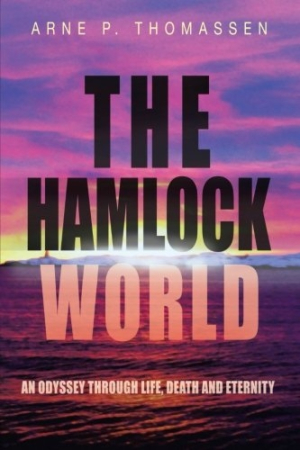The Hamlock World
An Odyssey through Life, Death and Eternity
Roger Hamlock, a brilliant inventor on the brink of a world-altering discovery, is killed in a suspicious car crash. As a disembodied spirit, he learns that misuse of his invention by a “hideous organization” will result in worldwide disaster for the human race unless he is able to stop it. Reincarnated and reborn, he sets out to avert disaster, armed with spiritual enlightenment, clairvoyance, and other rather vaguely defined supernatural abilities.
Some interesting plot ideas are embedded in this sprawling, idiosyncratic book. The first chapter, in which the disoriented protagonist explores the capabilities of his disembodied form while still not fully recognizing his deceased state, is perhaps the most enjoyable part of the book. Other plot devices that come to light later in the story are buried in a sea of clumsy phrasing, shallow characterization, improbable plot twists, and dei ex machinis. These problems worsen as the scope of the story expands from the individual to the universal.
The chief earthly villain, BIG Pa, is a charismatic cult leader reminiscent of a Jim Jones or David Koresh. He presides over a vast “brainwash society” that exerts sinister influence throughout the world. Additional villains include a cybernetic robot from an alien planet, who controls a worldwide conspiracy from a lair hidden beneath an idyllic Caribbean island, and General Yuk Chow, who leads the Great Moogo Empire, an Asian superpower that arises from obscure origins to start World War III.
Along the way, a succession of female spiritual guides and love interests appear, give the hero useful advice, and vanish without making much of an impression as individuals. Important parts of the plot, especially in the latter half of the book, are conveyed through authorial information dumps rather than via the experiences or thoughts of the characters. Such tactics have the unfortunate effect of distancing the reader from a story that is already difficult to follow.
The author’s many futuristic and metaphysical tropes are also difficult to track, making it a challenge for the reader to understand how they relate to the story in anything but the most cursory way. UFOs, Men in Black, clairvoyance, auras, reincarnation, cybernetic mind control, flying electronic battleships, death rays, evil spirits, dark energy, and psychological theories about emotional trauma are tossed willy-nilly into the stew as if the author hopes that they will somehow boil down into a some kind of grand unified theory. Frequent references to God, Christ, and the Holy Spirit suggest that Christianity is also part of the recipe, but the many flavors introduced do not blend harmoniously. Even the most attentive and sympathetic of readers will be exhausted and confused by the end of the story.
Reviewed by
Bradley A. Scott
Disclosure: This article is not an endorsement, but a review. The publisher of this book provided free copies of the book and paid a small fee to have their book reviewed by a professional reviewer. Foreword Reviews and Clarion Reviews make no guarantee that the publisher will receive a positive review. Foreword Magazine, Inc. is disclosing this in accordance with the Federal Trade Commission’s 16 CFR, Part 255.

